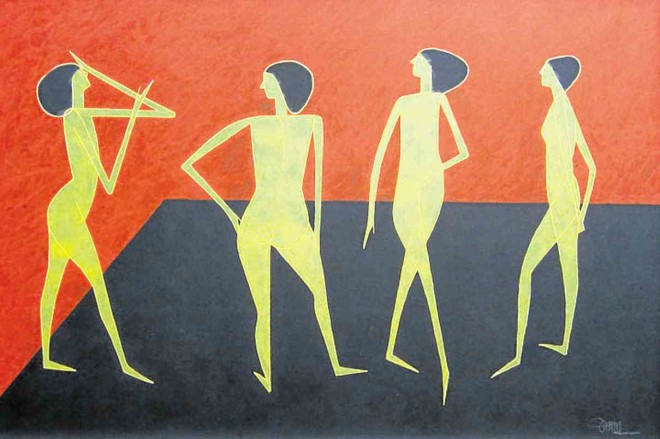
“YOU paint who you are. You are what you paint.” “My work is linear and geometric, and that’s it, essentially.” “Everything to me has become instinctive.” “Even black and white can be decorative.” “I can tell you in a second if a design works.”
Those words, uncluttered gems of insight and candor, were uttered spontaneously to this writer, in marathon taped interviews conducted through successive weekends that, when placed end to end, would stretch to a 24-hour nonstop conversation.
“Exhaustive” would be an understatement to describe the gruelling research proceedings in order to glean as much detailed information one needed to write the coffee-table book of one who has been famously described by the late esteemed art critic Leonidas Benesa as having “a mandarin sensibility.”
To be sure, only one Filipino artist could fit the bill: Arturo Luz. Without the appended “National Artist” (he was so proclaimed in 1997), the name would be as stark as one of his artworks. Such was the stature of the man who, at a once fabled time, reigned supreme as arbiter elegantiarum of the country’s visual arts.
As simultaneous head of three national institutions—Metropolitan Museum, Museum of Philippine Art, Design Center of the Philippines, not to mention the eponymous Luz Gallery, the premier art showcase in town—Luz virtually single-handedly reshaped and streamlined and stripped the trimmings off an errant natural penchant for the baroque, weaning us away from the over-the-top and excessive borloloy of our design aesthetics.
And exactly just what did that prepossessing phrase mean? Swiftly it flew and landed and stayed in the lexicon of local art reportage the moment it was inscribed in Benesa’s percipient review. Indeed, in the former imperial Chinese service, a mandarin was a powerful official, a senior bureaucrat.
Remaining giant
In celebration of National Heritage Month, Galerie Joaquin Main is presenting several of Luz’s masterworks, never before exhibited, in a show titled “Vintage Luz.”
He is, in my estimation, one of the last few remaining giants from the Golden Age of Philippine Art.
Many of the works are over two decades old, and the passage of time has further burnished the classic themes that range from jugglers, cyclists, acrobats, performers and musicians; to still lifes of ancient Oriental vessels as well as collages of shells, stones and wood sticks; cities of the past characterized by temples, forts and palaces; as well as pure abstract works of sheer formality, held in place by a delicate balancing act of tension and elegance.
Whence this sensibility, as severe and as distant from the serpentine undulations of bands of color that swept through the murals of, say, Carlos “Botong” Francisco, or the curvilinear feast of cellular forms wriggling in perpetual motion in an Hernando Ocampo canvas?
Remarked Luz: “I have always been impressed by anything linear.”
Thus, not surprisingly, a youthful adulation was for Paul Klee, who famously described line as “a dot that went for a walk.”
For Luz, who started to paint at age 17, and is now in the autumn of an artistic patriarch’s life, line has been the one element of unchanging constancy, a dot taken for a walk, through decades of unceasing and disciplined art-making.
But for all the seeming austerity and rigor of Luz’s lines, undeniable is the joyousness of his art, the passion to extract from line a “singing” quality, from the abrupt, sharp staccato-like delineations effected through a gleaming nib of a pen, to the long, sustained “arias” of the stretched taut lines that buildup, like a crescendo, evoking the rising steps, up, up, the equivalent entablatures of Indian forts and temples.
Patience of spider
The “Desert Plant, Rajasthan” series, for instance, is a tangle of thorns, a choking congestion of white slivers of lines swirling in tight, rhythmic unity, like piled-up barbed wires buried beneath the steamy black desert sand. To those who thought Luz espoused only a meagerness of execution, this series should come as a revelation.
Said Luz, matter-of-factly: “I have the patience of a spider.”
That paragon of still-life painting, Giorgio Morandi, sheds light on Luz, when we recall the Italian’s spindly and fluted bottles, pepper mills and flasks, pitchers and bowls, which, according to American critic Max Kozloff, in a left-handed compliment, have “nothing to support except his sensibility—a mode of seeing, a way of touching paint onto canvas, his counterpointed little groupings, a preference for certain colors within a very restricted range.”
Would that the critic had discovered as well the Filipino master’s still lifes: a pure exhalation of the vessels’ shapely form, as if glimpsed in aerated transparency, by turns full-bodied and ethereal. In place of Morandi’s pasty tangibility, Luz, ever the purist, negated any ambiguities of form, allowing no diffusion of contour or outline.
A draughtsman of the first order, National Artist Arturo Luz has parlayed the economy of line into a body of work distinguished by its clarity and finesse, precision and openness. No other Filipino artist, bar none, possesses such unerring sense of visual logic in the deployment of graphic elements and devices.
In large measure, the show “Vintage Luz” highlights all his virtues and strengths, with his unfailing instinct for line even more visible and laudable with the passing of time.
Galerie Joaquin Main is at San Juan. Call 7239253; visit www.galeriejoaquin.com.